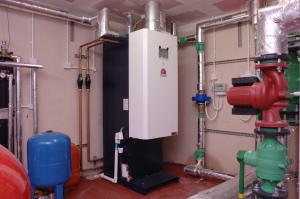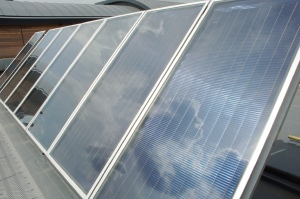When the Sun meets cold water

Solar-thermal water heating is an effective way of reducing carbon emissions and energy costs in commercial and public sector buildings. Jonathan Tedstone of Andrews Water Heaters explains how to maximise the benefits of this renewable technology.
Increasingly tight Building Regulations and steep environmental targets have encouraged greater use of low-carbon alternatives to meet high demands for hot water in commercial and public sector buildings. In particular, there has been a marked increase in uptake of solar-thermal heating solutions within both new build and existing properties especially when operated in conjunction with direct-fired water heaters.
Harnessing the power of the Sun to heat water is a proven renewable technology that has been available in this country for over 40 years. With the UK benefitting from around 60% of the solar energy that is received at the equator, well-designed solar-thermal solutions can capture this power and translate it into useful energy for hot-water systems.
One of the most effective uses of solar energy is to pre-heat water before it is delivered to direct-fired water heaters, as this significantly reduces the energy consumption of the appliances and, therefore, reduces energy bills whilst guaranteeing a reliable hot-water supply.
Commercial solar-thermal solutions use one of two types of solar collectors to harness solar energy — glazed flat plates or evacuated tubes. These easily-installed, roof-mounted solar collectors capture energy from solar irradiation, including infra-red and ultra-violet rays, so even on a cloudy day solar power can be used to support the production of hot water.
 |
| Pre-heating water before it is delivered to direct-fired water heaters is one of the most effective uses of solar energy. |
The heat absorbed by the collectors is typically passed into a transfer fluid which is then pumped through a coil in an unvented indirect cylinder, heating the stored water.
A typical low-carbon water-heating system uses a direct-fired water heater as the primary heating appliance to raise the incoming cold water supply from 10 to 60ºC — a legionella-safe water temperature (a separate boiler would provide the space heating).
A pre-heat cylinder supported by roof-mounted solar collectors pre-heats the feed water to the storage water heater. In this way, the solar energy helps raise the temperature of the feed water all year round, so that less energy is required to raise the water temperature to 60ºC.
Transmission efficiencies, absorption efficiencies and emissions from glazed flat plates and evacuated tube collectors are similar, although the latter offer higher thermal efficiencies due to an insulating vacuum within each tube that minimises heat loss — particularly in the winter.
In the UK, commercial solar thermal systems can supply 30 to 40% of the annual hot water load, known as the solar fraction (SF). In summer months, well-designed solar-thermal systems may supply almost all of the hot-water demand, whereas in winter the SF will drop to around 20% due to the lower available solar irradiation.
A water-heating system that combines this renewable energy technology with high-efficiency direct-fired water heaters will achieve the required reliability and fulfil high demand for hot water more sustainably, reducing the carbon emissions associated with hot-water generation.
 |
| Solar-thermal collectors can absorb infra-red and ultra-violet rays, so even on a cloudy day, hot-water production is supported. |
While there is clearly more benefit in the summer, solar thermal can be used to reduce the building’s carbon footprint all year round. Throughout the year, the solar-thermal system and direct-fired water heater will work in tandem, with the latter acting as a failsafe to ensure that there is no break in hot-water delivery.
The benefits of integrating low-carbon technologies into a water-heating system are clear. However, as with all sophisticated technology, it is advisable to work with the experts in order to maximise energy and carbon savings.
Where possible, it’s worthwhile sourcing all components from the same manufacturer, whose detailed knowledge of the products and how best to combine them will support best-practice design and installation.
Manufacturers with tried-and-tested experience in both technologies will also be able to offer a consultative approach throughout the project, from the initial site visit to the final commissioning stage.
Jonathan Tedstone is category manager at Andrews Water Heaters







